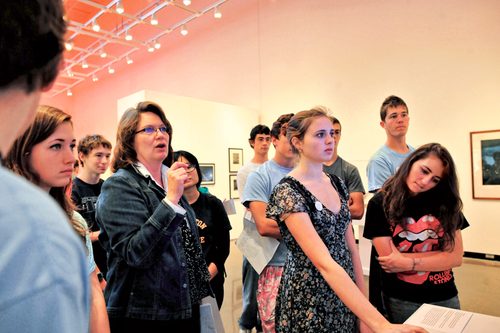 The Weitz Center for Creativity was designed for interdisciplinary teaching and learning, providing Carleton with much needed classroom space for all departments.
The Weitz Center for Creativity was designed for interdisciplinary teaching and learning, providing Carleton with much needed classroom space for all departments.
The center provides the space for new and unexpected combinations of faculty members and students to gather under the same roof, further encouraging learning that crosses disciplinary boundaries.
This past fall, numerous faculty members took advantage of the new teaching spaces, while others used the Seeing is Knowing: The Universe exhibition in the Perlman Teaching Museum as a teaching tool.
Computer science professor David Liben-Nowell taught “Life in the Age of Networks” in the Weitz Center’s Class of 1960 Interactive Classroom (shown above). His students analyzed networks: social, biological, technological, or other entities that are bound by some sort of relationship.
“A network can be based on friendship or dating, it can be websites linked together or computers wired together. People making phone calls or species eating each other also are networks,” says Liben-Nowell, whose research focuses on social networks. “In this class, we take a broad look at the mathematical properties of networks and how they process data, how we talk about them, and what role they play in society.”
According to Liben-Nowell, the course encouraged students to delve into a question that sociologists have been asking for a long time: How do groups work? “Thirty years ago, people thought about social networks according to classic social science methodology. They would observe a group of people interacting over time, maybe keeping track of a few dozen people at a time,” he says. “Now I can download datasets of 10 million users of MySpace, for example. It’s the difference between dozens of data points and millions of data points.” The students in his class also formed a data set, enabling them to study their own network created by the class.
Liben-Nowell compares teaching in the Weitz Center’s interactive classroom to being in a theater in the round as opposed to on a proscenium stage. “The space is very conducive to group work and getting students to talk to each other,” he says. There is no natural front of the room or a blackboard at which he stands. Rather, Liben-Nowell uses a tablet computer to write notes, which are projected to screens set high along the edges of the room for all to see. The room also is lined in whiteboards for further display space. Each table in the room has inputs to project information onto the screens.
“There is a lot of potential in this room to play pedagogically,” Liben-Nowell says. “The space definitely has an experimental feel to it.”

THE LANGUAGE OF LEARNING
Arabic professor Yaron Klein instructs his class in one of the Weitz Center’s restored classrooms.

COSMIC INSIGHTS
Students in physics professor Cindy Blaha’s cosmology seminar used the Seeing Is Knowing: The Universe exhibition as inspiration for a writing assignment. Blaha instructed her students to reflect on their most and least favorite objects as viewed from the perspective of someone unlike themselves, such as a senior citizen or a parent with a five-year-old child. The students then composed a poem, limerick, or haiku based on their reflections.
